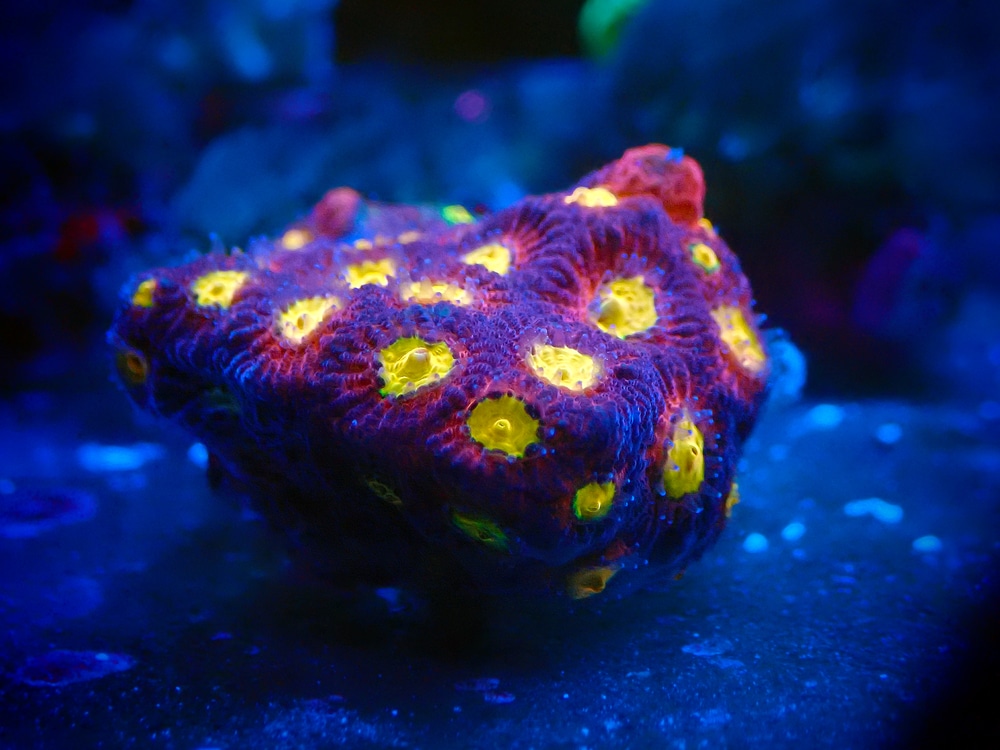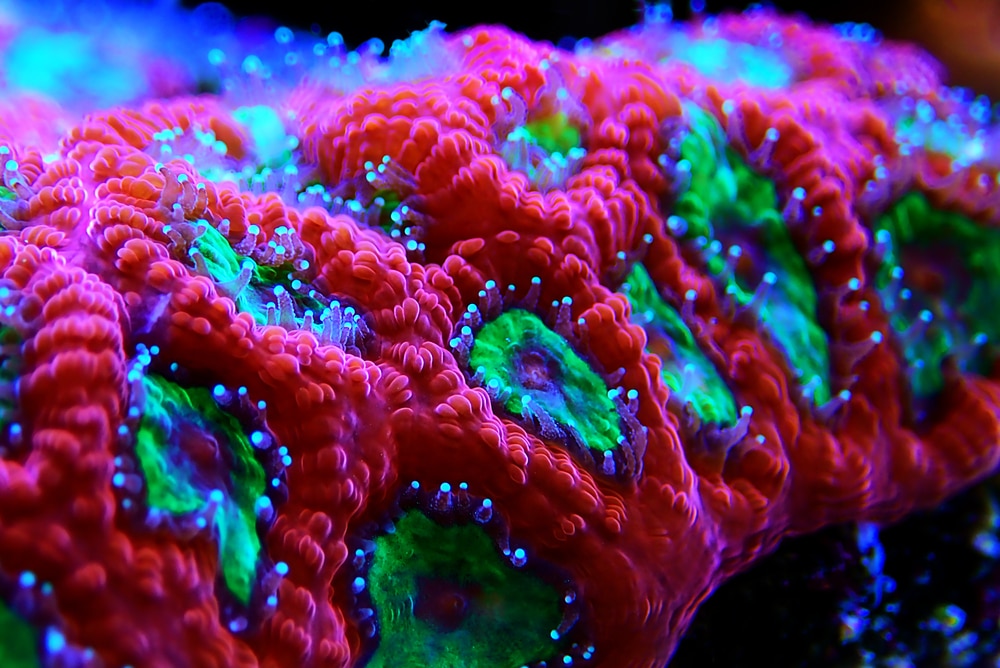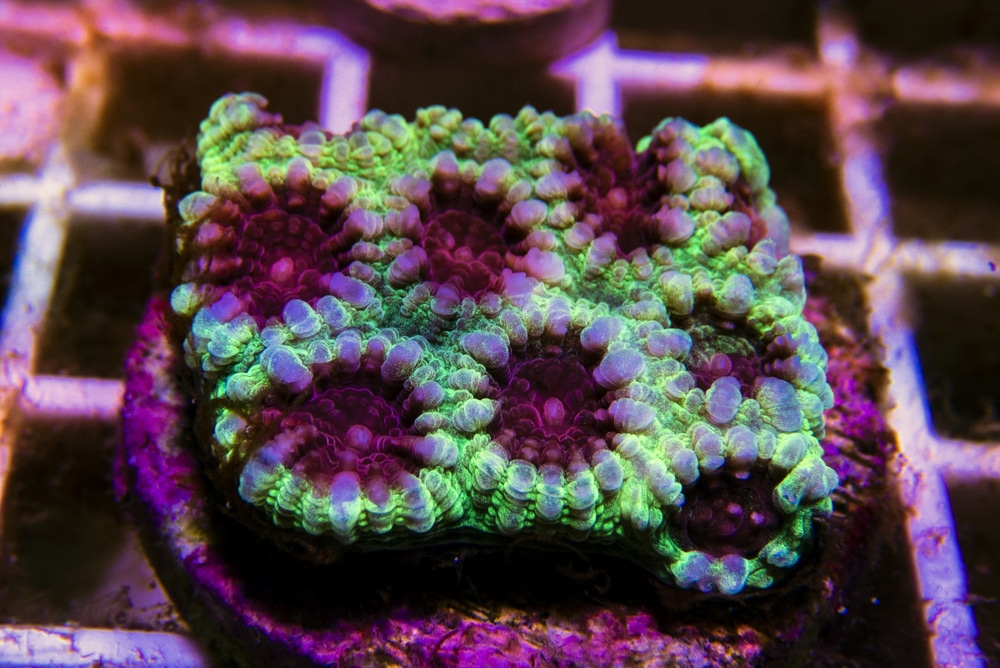If you’re interested in Brain Corals, Favia and Favites are favorites of reefkeepers all around the world. While they look exotic they are actually very stony coral beginner-friendly so long as you’re aware of basic reef aquarium care. They also come in an assortment of different colors. While they are some of the more slow growing and aggressive stony corals out there, most people can find space for a Favia or Favites!

What are Favia and Favites Coral?
Favia and Favites are two genera of brain corals, meaning that there are actually several species of coral in each group that share this name. They are both LPS (large polyp stony) corals that can form colonies as large as a meter across. Both genera also come in a wide range of attractive colors and are often available captive propagated! That said, they are slightly more difficult than other corals to frag so you will still see wild caught specimens on occasion.
While they are some of the more easily cared for LPS corals you do need to pay proper attention to the rate of water flow, lighting intensity, and dissolved mineral and nutrient levels. Like all stony corals, Favia and Favites have exacting needs for all of the above in order to sustain proper growth.
And being a more aggressive species, we need to be especially careful when choosing and placing Favia and Favites among other corals. Otherwise you may find damage to your other corals in the morning once their nightly warfare subsides! Let’s take a closer look at the beautiful Favia and Favites Corals!
- Common Names: Pineapple Coral, Brain Coral, Moon Coral, Closed Brain Coral (Favia sp.)
- Scientific Name: Favia sp. & Favites sp.
- Origin: Atlantic & IndoPacific
- Temperament: Aggressive
- Ease of Care: Easy

Favia or Favites?
Since Favia and Favites are closely related, come in several color varieties, and are the two most common brain corals in the hobby, it’s pretty easy to get them both mixed up.
The best way to tell is to study the corallites themselves. Corallites are the skeletal cups that each polyp creates around itself as it grows. In Favia corals, the corallites all have their own walls. This means you’ll see fused or even double walls separating the individual polyps. With Favites corals, the corallites share walls between one another. Once you’ve seen them side by side it’s significantly easier to tell them apart!
But in case that still sounds a little tricky, have a look at this video which clearly demonstrates the differences between the two genera!
Caring for Favia and Favites Coral
As far as stony corals go, Favia and Favites are some of the easiest and most beginner friendly species to care for. Just make sure to provide them with enough indirect flow, lighting, and nutrients and you should see sustained growth and excellent colors!
Water Conditions
The hardest part about keeping stony corals is adding precisely the right ingredients they need to survive – and then keeping the parameters in this ideal range. This is often tricky for beginners because many of these minerals, compounds, and elements interact with each other.
That said, the exact interactions of each element or compound are beyond the scope of this article. Just know that Brain Corals prefer the below parameters, which are actually favored by the majority of reef corals. We want nutrient levels, specifically nitrate and phosphate to be as low as possible without actually testing as 0 parts per million.
Both nitrate and phosphate are essential nutrients for the zooxanthellae (symbiotic algae) that live within the tissues of corals. But if your nutrient levels get too high, the strong lighting used in reef tanks will encourage green hair and macro algae to take off, potentially competing with your corals for living space.
Calcium, magnesium, and strontium are three important elements used by corals to build up their skeletal bases. Proper magnesium levels also increase the bioavailability of calcium for corals; if magnesium falls below 1200 ppm, calcium and alkalinity levels follow suit, precipitating out of solution and stalling coral growth rates. Strontium is a trace element whose role in coral growth isn’t as well understood. But all corals contain traces of it so it gets added to all marine salt blends.
It’s best to use reef aquarium salt blends, by the way, because they have higher levels of essential nutrients used by corals. Standard marine salt has the right concentrations to create seawater with the below parameters. But your coral population will quickly draw enough elements out of solution to stall their own growth.
As far as the other parameters are concerned, we want to provide reef standard conditions of 72-78℉ and a pH of 8.0-8.24, which is easily accomplished thanks to the crushed aragonite substrate used in most reef systems. The specific gravity (salinity) should also fall between 1.023 to 1.025. Alkalinity levels (how resistant your water is to shifts in pH) of 9-12 dKh are actually higher than seawater standard (7-8 dKh). But higher alkalinity levels have been shown to improve coral growth rates.
Lastly, Brain Corals enjoy moderate to high rates of flow. You don’t want to direct the output of your powerhead directly onto your corals as it can cause their polyps to retract. Instead, moderate indirect flow or circular flow set up across the entire tank is best. This way, excess mucus and debris that settles onto the corals can be swept away, keeping their surface clean. Just make sure to lower or turn off the flow entirely when feeding so food doesn’t go to waste.
- Temperature: 72-78℉
- pH: 8.0-8.24
- Specific Gravity: 1.023-1.025
- Alkalinity: 9-12 DKH
- Calcium: 350-450 ppm
- Magnesium: 1200-1350 ppm
- Nitrate: 1-10ppm
- Phosphate: 0.1 ppm

Lighting for Favia and Favites Coral
Favia and Favites need moderate to high lighting conditions. While they are also eager eaters they rely a fair amount on their zooxanthellae (symbiotic algae) for nutrition. Coral zooxanthellae provide corals with sugars created through photosynthesis. And in exchange corals provide their symbiotic algae with protection and nutrients. A measurement of 100 PAR (photosynthetically active radiation) or higher is best at the spot where you intend on placing your Brain Coral.
Favia and Favites also tend to show incredible colors when exposed to actinic lighting (10,000K+ in color temperature). Radiant greens, blues, and yellows will come to life if you can add an actinic bulb above the tank. PAR lighting tends to be more in the 6500K color temperature but you can use both bulbs for the best of both worlds!
Tank Mates for Favia and Favites Coral
You need to be a little more careful with tank mates where Brain Corals are concerned because they are some of the more aggressive types of corals out there. At first, the idea of “coral aggression” sounds a bit strange. After all, they are mostly or entirely sessile (unmoving) and can’t exactly attack a neighbor…Right?
As it turns out, corals have several strategies that they use to do anything from inhibit the growth of other corals to killing and even eating their nearest neighbors. In the case of Favia and Favites they will extend sweeper tentacles at night that aren’t normally visible during the day. These tentacles can add anywhere from 2 to 6 inches in additional reach – and these sweepers are packed with potent nematocysts (stinging cells).
Corals use their sweeper tentacles to both collect food that wafts by, like zooplankton and fish fry, and to sting and disable any other corals encroaching on their growing space. Sweeper tentacles do rely on the direction and power of the currents around the coral, meaning you can place neighboring corals closer if the currents will push the Brain Coral’s sweepers away from them. So long as the neighbor isn’t also an aggressive species, that is. Don’t keep Favia or Favites next to Acan Lords, Frogspawn, or Elegance Corals as they will sting each other relentlessly at night.
Wandering coral species like Ricordea and other mushroom corals can work, as can Toadstool Leather Corals. These species can adjust their position to avoid being stung if they wander too close to a Brain Coral at night.
Aggressive species like Brain Corals also make great tank mates for species who don’t have potent stings but tend to encroach on the space of other corals. Cyphastrea Coral, Green Star Polyps and Kenya Tree Corals are a few species known to simply overwhelm the competition. But the reach and potent nematocysts of a Brain Coral can be enough to keep them at bay permanently.
Favia and Favites can be kept with any reef safe fish or invertebrate as well. Reef safe fish include Pygmy Angelfish, Tangs, Damselfish, Clownfish, Gobies, Blennies, Cleaner Wrasses, and other fish that won’t pick at the extended polyps. Just be careful when feeding since many fish may be tempted to steal food from the corals since they eat quite slowly.
As far as invertebrates are concerned, any sessile or mobile invertebrate that won’t pick at coral polyps and can stay out of the reach of the Brain Coral sweeper tentacles will work. Shrimp are especially good choices, though stay away from Peppermint Shrimp (Lysmata wurdemanni) as they are known to enjoy nibbling on polyps if they don’t have majano or aiptasia anemones to feast on. Starfish, giant clams, feather duster worms, and well placed soft, LPS and SPS will all make excellent tank mates as well!
Good Tank Mates for Favia and Favites Corals:
- Pygmy Angelfish, Tangs, Damselfish, Clownfish, and other Reef Safe Fish
- Shrimp, Giant Clams, Feather Duster Worms, and other Invertebrates
- Soft, LPS, and SPS Corals (with caution)
Feeding Favia and Favites Coral
Corals are fascinating creatures because they actually use several feeding methods. They not only eat other animals but they also absorb dissolved organic material directly from the water column. Corals also partner up with symbiotic algae to use sunlight as a way of transforming water and carbon dioxide into nutritious sugars!
Some corals can subsist entirely on organic matter and light. But Brain Corals are eager eaters and should be fed at least once per week on appropriately sized foods. Zooplankton blends, brine shrimp, and chopped mysis shrimp will all provide a nutritional and growth boost for your corals. Brain Corals typically feed at night when their sweeper tentacles are extended. But they can easily be conditioned to feed during the day.
You’re better off target feeding Favites and Favia Corals with a pulse of zooplankton rather than broadcast feeding. Just make sure to turn off the strong current they normally favor so food doesn’t go to waste and rot, potentially causing ammonia levels to rise.
Propagating Favia and Favites Coral
Favia and Favites are increasingly propagated in captivity but are still wild collected on occasion because they can be a little more difficult to frag. Many corals can easily be split in half and they will quickly regenerate and take off. But the shared corallites of Favites makes them a challenge and both Favites and Favia are fairly slow growing, further hindering propagation attempt.
Favia Corals are the easier of the two genera to propagate because each corallite has its own wall. You can therefore cut in between the corallites using a water lubricated band saw and then glue your frags (fragments) onto a fragging disk for the new coral to recover. While Brain Corals grow fairly slowly they recover well from this process, so long as their wounds don’t get infected. Most of the time you’ll want to soak each new frag in iodine to prevent bacteria from taking hold. You can also add iodine to the saw’s lubricating water to further protect the coral frags.

